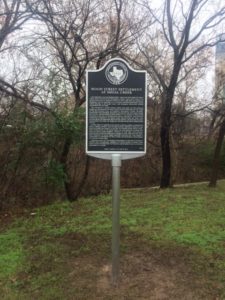Community organizations and activists, noting the impact of gentrification, have rallied to preserve the history and culture of East Austin. They recorded Tejano Voices on Gentrification for posterity and Remembering Tejano East Austin through the Tejano Trails Project. Organizations have also been established to protect and share the story of historically Latinx neighborhoods. The East Cesar Chavez Neighborhood Contact Team is dedicated to land and building preservation, the establishment of historical markers, and the creation of historic districts. The Austin Tejano Music Coalition “supports and expands the presence of a Native Texas genre of music known as Tejano and its artistic contribution throughout the community of Austin and Central Texas.” Finally, an Instagram account named ATX Barrio Archive has used social media to share images of black and Latinx Austinites and celebrate the cultural heritage of their historic neighborhoods. While gentrification remains an issue for Austin’s communities of color specifically and in the larger city of Austin generally, individuals and groups have continued the long tradition of activism and organization to advocate for their communities.

The northern half of Wood Street, near the west bank of Shoal Creek and extending to Henderson Street, was once home to a distinct enclave of African American and later Mexican American residents. As the frontier city's natural western boundary, Shoal Creek became a settling point for formerly enslaved people following the Civil War. The community along Shoal Creek was part of the African American settlements of West Austin which developed in the years after Reconstruction. As domestic servants, cooks, drivers, carpenters and laborers, residents influenced the lives and culture of Austin. Despite being surrounded by the homes of wealthier Anglos in the era of increasing racial prejudice, the African American community on Wood Street thrived into the 1920s. Two houses from the freedmen era endured several devastating floods and existed for over 100 years on the site before being demolished in 2014. As the 1928 city master plan pushed African American residents into a "Negro district" east of East Avenue, Hispanics (Mexican and Mexican American) began to occupy the houses along Shoal Creek, likely connected to the significant cultural enclave located just east of Shoal Creek dubbed "Mexico" at the time. While racial segregation concentrated most Tejanos in East Austin by the 1920s, the community at Shoal Creek persisted through the 1970s where it continued to contribute to the cultural and economic development of the downtown area. Although many of the physical reminders of this era in Austin's history have disappeared, residents of Wood Street at Shoal Creek were major contributors to the rich and diverse ethnic historical geography of Austin. 2016. Marker is property of the State of Texas.
Eliot Tretter’s Austin Restricted: Progressivism, Zoning, Private Racial Covenants, and the Making of a Segregated City delves into the history of racial segregation in Austin and its effects on its residents of color.
Recreational facilities, including the Pan American Recreation Center on East 3rd Street, the South Austin Recreation Center, and the Montopolis Neighborhood Center were established at the behest of community members vocalizing the need for public spaces for the Latinx community. The Austin History Center’s Mexican American Resource Guide: Sources of Information Relating to the Mexican American Community in Austin and Travis County contains archival material related to the creation of these recreation centers, along with other important sites and people in the Latinx community.
For more on the Civil Rights Movement in Texas, as well as the relationship between black and Latinx activists at this time, visit Civil Rights in the Texas Handbook and “How Latino and African American Solidarity Built a Better Austin.” A recent documentary entitled “Mexican American Legislative Caucus: The Texas Struggle for Equality and Opportunity” explores the history of Tejano efforts to establish equity and inclusion in the state.
Austin Renters and People of Color Most Likely to Be Displaced Because of Gentrification explains issues of displacement, while a recent city report Land of Broken Dreams and Land of Opportunity studies homeownership trends in the Chestnut, East Cesar Chavez, and Holly neighborhoods, finding that “in the span of 10 years, more than 1/3 of long-time homeowners no longer live in their neighborhood”